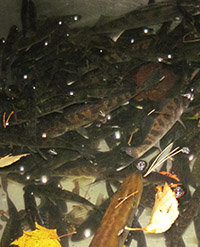Minocqua Chain Walleye
Fishing Wisconsin
How the Department proposes to revitalize a walleye fishery
The Minocqua Chain is a 5,929-acre chain of lakes in Oneida County. The chain includes Kawaguesaga, Minocqua, Jerome, Mid, Tomahawk, Little Tomahawk and Mud lakes, along with the Minocqua and Tomahawk thoroughfares. The Minocqua Chain forms the headwaters of the Tomahawk River and is part of the Upper Wisconsin River watershed. Tomahawk (3,462 acres), Minocqua (1,339 acres) and Kawaguesaga (700 acres) are the largest lakes of the chain and provide the majority of the walleye spawning habitat.
The problem: The adult walleye population and natural reproduction of the Minocqua Chain of Lakes in Oneida County have experienced a substantial decline since the early 1990s because of the low recruitment of young fish into the population.
The solution: Implement a cooperative rehabilitation project that seeks to restore healthy, self-sustaining walleye populations. (A density of at least three adult fish per acre in lakes Minocqua and Kawaguesaga, and at least two adult fish per acre in Lake Tomahawk).
Minocqua Chain project
A cooperative rehabilitation project that seeks to restore healthy, self-sustaining walleye populations.
Surveys/stocking
Fisheries biologists use netting and electrofishing surveys to monitor fish populations. Adult walleye surveys are performed during the spring of the year when the fish are spawning. We mark the adult fish with fin clips and use the data to estimate the number of adult fish in each lake. Electrofishing surveys during the fall are used to measure recruitment and the number of young fish coming into the population. During the fall recruitment surveys, we look at the number of young-of-year walleye (meaning fish that were hatched last spring and have made it through their first summer) and age-1 walleye (fish that have made it through two summers of life). Our catch of these small fish gives us a good index of how many young walleye are coming up. Natural walleye recruitment is often very hit-and-miss, but one moderate to strong year class every few years is enough to sustain an adult population. If natural walleye recruitment falls off, then biologists can stock fish from DNR hatcheries to maintain their numbers.
Minocqua Chain Walleye Survey and Stocking Information [PDF]
Closure extension
Moving forward...
Minocqua Chain of Lakes: The adult walleye population and natural reproduction of the Minocqua Chain of Lakes in Oneida County have experienced a substantial decline since the early 2000s because of the low recruitment of young fish into the population. Given the lack of significant natural reproduction, a partner group* recommended closing the Minocqua Chain to walleye harvest by all methods (including both angling and tribal spring harvest) - catch and release fishing only - through May 2025. The regulation planned for 2025 is an 18-inch minimum length limit, but walleye from 22 to 28 inches may not be kept; one walleye daily bag limit.
*Great Lakes Indian Fish and Wildlife Commission, Headwaters Chapter of Walleyes for Tomorrow, Lac du Flambeau Tribe and the Tribal Natural Resources Department, Mid Lake Management and Protection District, Minocqua/Kawaguesaga Lakes Protection Association Inc., Tomahawk Lake Association Inc., Wisconsin Department of Natural Resources and Wisconsin Valley Improvement Company.
Public survey
The survey on the Minocqua Chain has been closed. We thank those who provided input.

